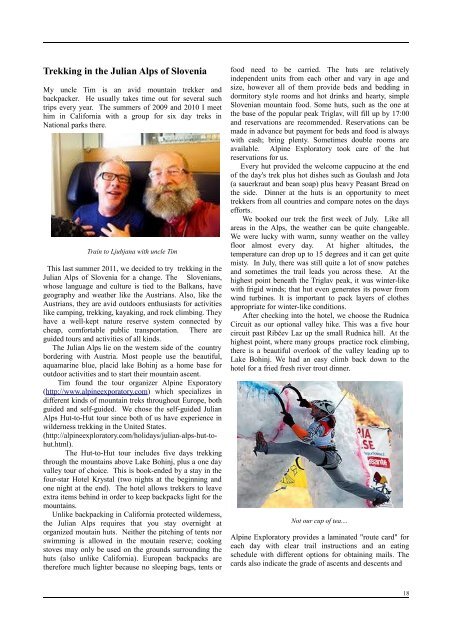Download (PDF, 9.14MB) - Kanovereniging Zeeburg
Download (PDF, 9.14MB) - Kanovereniging Zeeburg
Download (PDF, 9.14MB) - Kanovereniging Zeeburg
You also want an ePaper? Increase the reach of your titles
YUMPU automatically turns print PDFs into web optimized ePapers that Google loves.
Trekking in the Julian Alps of Slovenia<br />
My uncle Tim is an avid mountain trekker and<br />
backpacker. He usually takes time out for several such<br />
trips every year. The summers of 2009 and 2010 I meet<br />
him in California with a group for six day treks in<br />
National parks there.<br />
Train to Ljubjana with uncle Tim<br />
This last summer 2011, we decided to try trekking in the<br />
Julian Alps of Slovenia for a change. The Slovenians,<br />
whose language and culture is tied to the Balkans, have<br />
geography and weather like the Austrians. Also, like the<br />
Austrians, they are avid outdoors enthusiasts for activities<br />
like camping, trekking, kayaking, and rock climbing. They<br />
have a well-kept nature reserve system connected by<br />
cheap, comfortable public transportation. There are<br />
guided tours and activities of all kinds.<br />
The Julian Alps lie on the western side of the country<br />
bordering with Austria. Most people use the beautiful,<br />
aquamarine blue, placid lake Bohinj as a home base for<br />
outdoor activities and to start their mountain ascent.<br />
Tim found the tour organizer Alpine Exporatory<br />
(http://www.alpineexporatory.com) which specializes in<br />
different kinds of mountain treks throughout Europe, both<br />
guided and self-guided. We chose the self-guided Julian<br />
Alps Hut-to-Hut tour since both of us have experience in<br />
wilderness trekking in the United States.<br />
(http://alpineexploratory.com/holidays/julian-alps-hut-tohut.html).<br />
The Hut-to-Hut tour includes five days trekking<br />
through the mountains above Lake Bohinj, plus a one day<br />
valley tour of choice. This is book-ended by a stay in the<br />
four-star Hotel Krystal (two nights at the beginning and<br />
one night at the end). The hotel allows trekkers to leave<br />
extra items behind in order to keep backpacks light for the<br />
mountains.<br />
Unlike backpacking in California protected wilderness,<br />
the Julian Alps requires that you stay overnight at<br />
organized moutain huts. Neither the pitching of tents nor<br />
swimming is allowed in the moutain reserve; cooking<br />
stoves may only be used on the grounds surrounding the<br />
huts (also unlike California). European backpacks are<br />
therefore much lighter because no sleeping bags, tents or<br />
food need to be carried. The huts are relatively<br />
independent units from each other and vary in age and<br />
size, however all of them provide beds and bedding in<br />
dormitory style rooms and hot drinks and hearty, simple<br />
Slovenian mountain food. Some huts, such as the one at<br />
the base of the popular peak Triglav, will fill up by 17:00<br />
and reservations are recommended. Reservations can be<br />
made in advance but payment for beds and food is always<br />
with cash; bring plenty. Sometimes double rooms are<br />
available. Alpine Exploratory took care of the hut<br />
reservations for us.<br />
Every hut provided the welcome cappucino at the end<br />
of the day's trek plus hot dishes such as Goulash and Jota<br />
(a sauerkraut and bean soap) plus heavy Peasant Bread on<br />
the side. Dinner at the huts is an opportunity to meet<br />
trekkers from all countries and compare notes on the days<br />
efforts.<br />
We booked our trek the first week of July. Like all<br />
areas in the Alps, the weather can be quite changeable.<br />
We were lucky with warm, sunny weather on the valley<br />
floor almost every day. At higher altitudes, the<br />
temperature can drop up to 15 degrees and it can get quite<br />
misty. In July, there was still quite a lot of snow patches<br />
and sometimes the trail leads you across these. At the<br />
highest point beneath the Triglav peak, it was winter-like<br />
with frigid winds; that hut even generates its power from<br />
wind turbines. It is important to pack layers of clothes<br />
appropriate for winter-like conditions.<br />
After checking into the hotel, we choose the Rudnica<br />
Circuit as our optional valley hike. This was a five hour<br />
circuit past Ribčev Laz up the small Rudnica hill. At the<br />
highest point, where many groups practice rock climbing,<br />
there is a beautiful overlook of the valley leading up to<br />
Lake Bohinj. We had an easy climb back down to the<br />
hotel for a fried fresh river trout dinner.<br />
Not our cup of tea....<br />
Alpine Exploratory provides a laminated "route card" for<br />
each day with clear trail instructions and an eating<br />
schedule with different options for obtaining mails. The<br />
cards also indicate the grade of ascents and descents and<br />
18


